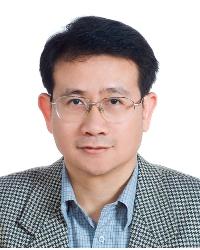林清富 Ching-Fuh Lin
光電創新研究中心創立主任
Founding Director of Innovative Photonics Research Center
主要研究領域:
太陽能無人機、太陽能電池及光電元件、單晶矽薄膜太陽能電池與矽奈米線太陽能電池、氧化鋅發光二極體、矽光子、寬頻半導體雷射以及半導體光放大器。Major Research Areas:
Organic-inorganic composite thin-film solar cells 、Single-crystal Si thin-film solar cells & 、ZnO-based LEDs 、Si-based photonics 、Broadband semiconductor lasers and optical研究領域摘要:
(一) 中文
開發出高效能的矽奈米線/有機太陽能電池,效率達10%以上;以及透過上下兩個氧化物夾住有機物質,以提供良好的保護,因而提高其穩定性,且帶來更高的電子收集效益。最特殊的部分是,我們是世上首次用溶液製鍍的方式,將無機材料鋪在有機層之上,因此整個夾層結構可用溶液製程完成,在成本降低的同時亦能兼顧與印刷技術的高相容性。此外,也開發超薄結晶矽薄膜的技術,首創溶液蝕刻的方式來取代鑽石刀機械切割技術,可以將單晶矽基板反覆切割,厚度可控制在5-20微米(5-20 um),只有鑽石刀機械切割的十分之一,可以大幅降低結晶矽太陽能電池的材料成本到只剩十分之一以下,以及發現有機無機的奈米結構組成對光伏裝置的電源轉換效率有顯著的影響。
1.開發矽奈米太陽能電池效率達10%。
2.成功開發ZnO有機光伏反向結構技術,提高電源轉換效率達7% 以上。
3.開發基植於塑膠基板上的ZnO奈米光伏裝置,並利用反向結構達到3.95%的能源轉換率。
4.成功提高未封裝有機太陽能電池於14500小時完工使用後能仍保持95%以上的轉換效益。
5.開發基植於外來基板的垂直奈米結晶薄膜量化轉移技術,降低太陽能矽晶元的材料成本。
6.開發出結晶矽薄膜之大面積轉移技術。
(二) 中文
研究奈米結構對光子內所的影響。矽晶內的奈米尺寸,使電子和電洞的配對過程中具有非常不同的行為,從而大大提高了輻射再複合的機率。在這部份我們取得了以下成果:
1.首位發現近似雷射放射受限狀態與由奈米粒子所支持之矽能帶共振效應。(MRS Bulletin News 於2002年6月報導,2003年3月於雷射世界最新突破中報導)
2.在金屬二氧化矽奈米矽結構的矽能帶中成功達成外部量子效率 > 10-4。
3.第一位使用矽結構技術並利用金屬光子盒使得調整後的黑體輻射大大強化了藍色光譜。
4.發明可雷射可塑技術,利用次級微球形共振器平滑化矽波表面使其粗糙度降低到小於0.2奈米。
(三) 中文
研究不同量子井的載子分佈和動態,以及用於寬頻半導體光學裝置的量子點。不同量子井中的載子分佈並不一致,但透過設計使得寬頻的特性可以通過適當的量子井結構佈局來實現。透過我們的研究,得以達成以下成果:
1.世界紀錄頻寬之高輝度發光二極體,FWHM頻寬:
400 nm (1250 -1650nm) for InGaAsP/InP type
and 91.5 nm (763 ~ 854.5 nm)
or AlGaAs/GaAs type.
2.世界紀錄波長調節範圍之可調式半導體雷射,單波長可調範圍至
240 nm(從 1300 nm到1540 nm)。
3.世界紀錄波長調節範圍之可調式雙波長半導體雷射,雙波長光譜分離由幾奈米可調到190奈米。
4.可同時產生20奈米間距的8個通道跨距從1367 nm到1527 nm。
5.在多重量子井中發現可影響載子不均勻分佈的因素。
(四) 中文
運用太陽能電池,裝置在四軸無人機上,提供無人機需要的電力,讓四軸無人機可以滯空達三小時以上,目前我們達到以下成果:
1. 太陽能四軸無人機,飛行時間達3小時28分鐘。
2. 極輕量化及高效率的太陽能模組,重量僅約1公斤,功率達300W。
3. 可以垂直起降,方便使用。
4. 可以手機控制,以及自動飛行等等。
Research Summary:
(一) 英文
l Explore organic solar cells with inverted structures. The organic layer is sandwiched by two oxides to provide good protection on the organic materials for improved stability and electron/hole blocking functions for efficient cerrier collection. The most promising part of this technique is that the sandwiched structure is fabricated using full solution process, so the cost could be very low and the production is potentially high for its compatibility with printing technology. Also, technology of forming very thin film of crystalline Si is developed.
1. Develop Si nanowires/PEDOT solar cells with efficiency >10%.
2. Invent solution processing technology for sandwiched inverted structures of ZnO /organic photovoltaic devices to achieve power-conversion efficiency of above 7 %.
3. Achieve good stability of unencapsulated organic solar cells with the efficiency retained 95% of the best vaue after 14500 hours of the fabrication.
4. Invent massive transfer technology of vertically aligned nanowires/nano-structure film from crystalline wafer.
5. Invent massive transfer technology of crystalline Si thin film to alien substrates to alien substrates to enable Si-soalr cells with very low material cost.
(二) 英文
l Investigation on the influences of nano-structures on photonics. The confinement of electron-hole pairs in the nano-domain gives rise to very different behaviors in the Si crystals, leading to greatly enhanced radiative-recombination probability. Also, the nano-structures in organic-inorganic composites result in significantly enhanced power conversion efficiency of photovoltaic devices. In this area, we have achieved the following results
1. First demonstration of nearly lasing phenomena such as threshold behavior and resonance modes from Si at the Si bandgap energy with the assistance of SiO2 nanoparticles. (News report by MRS Bulletin News, June 2002 and NewsBreaks in Laser Focus World, March 2003).
2. Achieve external quantum efficiency > 10-4 at the Si bandgap energy from metal-SiO2 nanoparticle-silicon structure on Si.
3. First demonstration on the modification of the black-body radiation to significantly enhance the blue spectrum using metallic photonic boxes based on Si fabrication technology.
4. Invent laser reformation technique to smoothen the surface of Si waveguides and sub-micro-sphere resonators with surface roughness reduced to less than 0.2 nm.
(三) 英文
l Research on carrier distribution and dynamics in non-identical quantum wells and quantum dots for broadband semiconductor optical devices. The carrier distribution in non-identical quantum wells is not uniform, but can be engineered, so broadband characteristics can be realized by proper layout of the quantum-well structure. With our investigation, we are able to achieve the following record research results.
1. Achieve record broadband superluminescent diodes, FWHM bandwidth: 400 nm (1250- 1650nm) for InGaAsP/InP type and 91.5 nm (763 ~ 854.5 nm) for AlGaAs/GaAs type.
2. Achieve record tuning range for tunable semiconductor lasers, single wavelength tuning range 240 nm (from 1300 nm to 1540 nm).
3. Achieve record tuning range for tunable dual-wavelength semiconductor lasers with spectral separation tunable from a few nm up to 190 nm.
4. Simultaneous generation of 8 channels with 20 nm channel spacing, spanning from 1367 nm to 1527 nm.
5. Discover new factors that influence the nonuniform carrier distribution among multiple quantum wells.

-
B.S.
Electrical Engineering, National Taiwan University, 1983 -
M.S.
Electrical Engineering, Cornell University , 1989 -
Ph.D.
Electrical Engineering, Cornell University, 1993
-
Address
BL-414,
Department of Electrical Engineering,
National Taiwan University,
Taipei 106, Taiwan -
Phone
+886-2-33663540 -
FAX
+886-2-2364 2603 -
Email:

-
Office Hour
Mon. 2:30-3:30 pm, Wed. 2:00-3:00 pm.